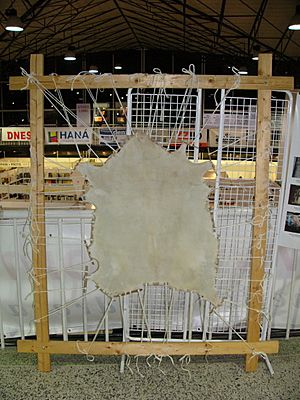Parchment facts for kids
Parchment is a special material made from animal skin. For hundreds of years, people used parchment as a strong and smooth surface for writing important documents and books. It was especially popular before paper became widely available. Parchment is different from leather because of how it's made. While leather is "tanned" using chemicals, parchment is "limed" and stretched. This process makes it very durable and long-lasting. The very best quality of parchment is called vellum, which is known for being extra fine and smooth.
Contents
What is Parchment and Why Was It Used?
Parchment is a thin, strong material created from the skin of animals. Most often, it came from sheep, goats, or calves. Its main purpose was to be a writing surface, especially for the pages of books. Before paper became common, parchment was one of the best materials for preserving written information. It was much more durable than papyrus, another ancient writing material.
How is Parchment Made?
Making parchment is a detailed process that takes several steps. First, animal skins are cleaned and soaked in water to remove dirt. Then, they are put into a solution of lime (a type of calcium carbonate) and water. This step helps to remove the animal's hair and any remaining flesh.
After the lime bath, workers carefully scrape the skin on both sides. They use a special curved knife called a "lunellum." This scraping makes the skin thinner and smoother. Next, the skin is stretched tightly on a wooden frame called a "herse." While it's stretched, the skin is scraped again and again. This stretching and scraping helps the fibers in the skin to align. It also makes the surface very flat and even.
Finally, the parchment is often rubbed with pumice stone to make it even smoother. Sometimes, chalk is also rubbed into the surface. This helps the ink to stick better when someone writes on it. The finished parchment is then ready to be cut into sheets for writing or binding into books.
The History of Parchment
Parchment has a long and fascinating history. It was first developed in ancient times, possibly in Ancient Egypt or Mesopotamia. However, it became very important in the ancient city of Pergamum (in modern-day Turkey). According to legend, the king of Pergamum wanted to build a great library. But Egypt stopped exporting papyrus, so Pergamum needed a new writing material. This led to the improvement and widespread use of parchment.
During the Middle Ages (around 500 to 1500 AD), parchment was the main material for writing in Europe. Monks in monasteries spent countless hours copying books onto parchment. These books, called manuscripts, were often beautifully decorated. They included religious texts, historical records, and scientific writings. Parchment was also used for important legal documents, charters, and maps.
Parchment vs. Vellum vs. Leather
It's easy to confuse parchment with vellum or leather, but they are different.
- Parchment is animal skin that has been "limed" and stretched. It's not tanned. This process makes it stiff and smooth, perfect for writing.
- Vellum is a very high-quality type of parchment. It is usually made from the skin of very young animals, like calves or lambs. Vellum is known for being extremely thin, smooth, and durable. Many important historical documents, like the United States Constitution, are written on vellum.
- Leather is also made from animal skin, but it goes through a different process called "tanning." Tanning uses chemicals to make the skin flexible and resistant to decay. Leather is used for things like shoes, bags, and clothing, not usually for writing.
Why Was Parchment So Important?
Parchment was incredibly important for several reasons:
- Durability: It is very strong and can last for hundreds, even thousands, of years if stored properly. This helped preserve ancient knowledge.
- Reusability: If a scribe made a mistake, they could often scrape the ink off the parchment and write over it. Sometimes, old texts were even scraped off entirely to make room for new ones. These are called palimpsests.
- Availability: Unlike papyrus, which grew mainly in Egypt, animal skins were available almost everywhere. This made parchment a more accessible material for writing across different regions.
- Writing Surface: Its smooth, non-absorbent surface was excellent for writing with quill pens and ink. It allowed for fine details and beautiful calligraphy.
Even after paper became more common in the 14th and 15th centuries, parchment continued to be used for very important documents. Today, it is still used for some special purposes, like official diplomas or religious texts.
Images for kids
-
A Sefer Torah, the traditional form of the Hebrew Bible, is a scroll of parchment.
See also
 In Spanish: Pergamino para niños
In Spanish: Pergamino para niños







